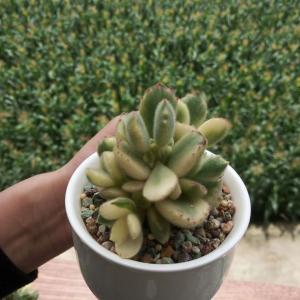文章
Dummer. ゛☀
2017年07月19日

Family - Asteraceae
Stems - Herbaceous, erect, to +60cm tall, from a thick caudex, simple below but branching in the apical 1/2 (inflorescence), terete, 2-4mm n diameter, typically multiple from the base, glabrescent at the base, scabrous and pubescent in the apical 1/2, with many small antrorse multicellular (use a lens to see) trichomes, light green and often with darker green vertical striations.

Leaves - Alternate, petiolate. Lowest leaves long petiolate. Petioles narrowly winged by decurrent leaf tissue, mostly glabrous. Blades linear-elliptic, with a few coarse but shallow teeth or entire, somewhat scabrous from the thickened bases of the hairs, antrorse strigillose on the margins. Leaf and petiole combined to +15cm long, 1cm broad. Cauline leaves reduced upward, becoming scale-like in the inflorescence. All leaves with a cartilaginous margin approximately .1mm broad. Light from underneath to see this.
Inflorescence - Corymbose arrangement of flower heads. Peduncles bracteate with reduced leaves, often with some arachnoid pubescence.
Involucre -To +/-6mm long and broad, cupulate to cylindric. Phyllaries imbricate, appressed, oblong, acute at the apex, to 5mm long, 1.4mm broad, glabrous externally, with a few appressed hairs or glabrous internally. Margins entire or minutely ciliolate, mostly scarious in the middle portion, with darker green apices, pale at the base.

Ray flowers - +/-12 per flower head, pistillate, fertile. Ligules glabrous, white, 5-7mm long, 2-3mm broad. Corolla tube white, +/-2mm long, glabrous. Pistil glabrous, becoming purple towards the apex, to 2.7mm long, bifurcate at the apex for +/-.4mm. Achene to +1mm long in flower, white, glabrous. Pappus of numerous capillary bristles. Bristles white, barbellate, -5mm long.
Disk flowers - Disk 6mm broad, with many flowers. Corolla 4mm long, pale yellow in the apical 1/2, greenish basally, glabrous externally and internally, 5-lobed. Lobes acute, .5mm long, erect to slightly spreading. Stamens 5, adnate at the base of the corolla tube. Filaments translucent, 2-2.2mm long, glabrous, compressed. Anthers connate around the style, 1.5-1.9mm long, yellow, drying to brown. Style to 4mm long, greenish-translucent, glabrous, bifurcate in the apical 1mm. The stigmas erect. Achenes glabrous, ribbed, 1-1.3mm long in flower, greenish-white. Pappus of capillary bristles. Bristles barbellate, to 4mm long, white. Receptacle flat, naked, -2mm broad.
Flowering - July - September.
Habitat - Rocky prairies, glades, bluffs, rocky open woods.
Origin - Native to U.S.
Other info. - This small species of Solidago can be found in the Ozark region of Missouri. The plant is unusual for a Goldenrod as the flowers are white instead of the typical yellow, and the flower heads are quite large for a Solidago. Because of these characteristics, the plant used to belong to the genus Aster. The old name was Aster ptarmicoides (Nees) T. & G.
Stems - Herbaceous, erect, to +60cm tall, from a thick caudex, simple below but branching in the apical 1/2 (inflorescence), terete, 2-4mm n diameter, typically multiple from the base, glabrescent at the base, scabrous and pubescent in the apical 1/2, with many small antrorse multicellular (use a lens to see) trichomes, light green and often with darker green vertical striations.

Leaves - Alternate, petiolate. Lowest leaves long petiolate. Petioles narrowly winged by decurrent leaf tissue, mostly glabrous. Blades linear-elliptic, with a few coarse but shallow teeth or entire, somewhat scabrous from the thickened bases of the hairs, antrorse strigillose on the margins. Leaf and petiole combined to +15cm long, 1cm broad. Cauline leaves reduced upward, becoming scale-like in the inflorescence. All leaves with a cartilaginous margin approximately .1mm broad. Light from underneath to see this.
Inflorescence - Corymbose arrangement of flower heads. Peduncles bracteate with reduced leaves, often with some arachnoid pubescence.
Involucre -To +/-6mm long and broad, cupulate to cylindric. Phyllaries imbricate, appressed, oblong, acute at the apex, to 5mm long, 1.4mm broad, glabrous externally, with a few appressed hairs or glabrous internally. Margins entire or minutely ciliolate, mostly scarious in the middle portion, with darker green apices, pale at the base.

Ray flowers - +/-12 per flower head, pistillate, fertile. Ligules glabrous, white, 5-7mm long, 2-3mm broad. Corolla tube white, +/-2mm long, glabrous. Pistil glabrous, becoming purple towards the apex, to 2.7mm long, bifurcate at the apex for +/-.4mm. Achene to +1mm long in flower, white, glabrous. Pappus of numerous capillary bristles. Bristles white, barbellate, -5mm long.
Disk flowers - Disk 6mm broad, with many flowers. Corolla 4mm long, pale yellow in the apical 1/2, greenish basally, glabrous externally and internally, 5-lobed. Lobes acute, .5mm long, erect to slightly spreading. Stamens 5, adnate at the base of the corolla tube. Filaments translucent, 2-2.2mm long, glabrous, compressed. Anthers connate around the style, 1.5-1.9mm long, yellow, drying to brown. Style to 4mm long, greenish-translucent, glabrous, bifurcate in the apical 1mm. The stigmas erect. Achenes glabrous, ribbed, 1-1.3mm long in flower, greenish-white. Pappus of capillary bristles. Bristles barbellate, to 4mm long, white. Receptacle flat, naked, -2mm broad.
Flowering - July - September.
Habitat - Rocky prairies, glades, bluffs, rocky open woods.
Origin - Native to U.S.
Other info. - This small species of Solidago can be found in the Ozark region of Missouri. The plant is unusual for a Goldenrod as the flowers are white instead of the typical yellow, and the flower heads are quite large for a Solidago. Because of these characteristics, the plant used to belong to the genus Aster. The old name was Aster ptarmicoides (Nees) T. & G.
0
0
文章
Dummer. ゛☀
2017年07月18日

Family - Saxifragaceae
Stems - From a bulbous fleshy whitish cormlike base with fibrous roots, clumping. Scape to +/-7cm tall, sparse to densely pilose,(some of the hairs with reddish glandular apices), herbaceous, erect.

Leaves - Basal, petiolate, +/-2cm long, +/-1.2cm broad, firm and crisp, often with reddish margins, glabrous and entire but with strigillose margins, ovate, rounded at apex, with slightly undulate margins. Petiole short, flattened, +/-5mm long.
Inflorescence - Terminal compact capitate cluster of cymules.(Say that five times fast). Each cymule subtended by a thin linear bract. Bracts often reddish near apex. Branches of inflorescence pilose.

Flowers - Petals 5, white, distinct, glabrous, subrotund, to 3mm in diameter. Stamens 10, arising from base of petals and sepals. Filaments to 1.5mm long, glabrous, greenish-white. Anthers orange, 1mm long. Ovary inferior. 3-carpellate. Placentation axile. Ovules many. Styles 3, green, 1.3mm long. Calyx tube turbinate, 2mm long, 5-lobed, glabrous. Lobes +/-3mm long, 2mm broad, glabrous, rounded to subacute at apex, often with a minute reddish tip.

Flowering - April - May.
Habitat - Sandstone glades and rocky prairies.
Origin - Native to U.S.
Other info. - Although the woodland plants are typically the harbingers of spring, this little glade plant blooms with or before all of them. The small clusters of white flowers stand out on their rocky substrata and typically the plant occurs in large colonies. This plant can be distinguished from the related S. virginiesis Michx. in that it stays small and compact even after flowering. The latter plant gets quite a bit taller and also occurs in more western counties of the state. S. texana occurs in the southeastern corner of Missouri.
Stems - From a bulbous fleshy whitish cormlike base with fibrous roots, clumping. Scape to +/-7cm tall, sparse to densely pilose,(some of the hairs with reddish glandular apices), herbaceous, erect.

Leaves - Basal, petiolate, +/-2cm long, +/-1.2cm broad, firm and crisp, often with reddish margins, glabrous and entire but with strigillose margins, ovate, rounded at apex, with slightly undulate margins. Petiole short, flattened, +/-5mm long.
Inflorescence - Terminal compact capitate cluster of cymules.(Say that five times fast). Each cymule subtended by a thin linear bract. Bracts often reddish near apex. Branches of inflorescence pilose.

Flowers - Petals 5, white, distinct, glabrous, subrotund, to 3mm in diameter. Stamens 10, arising from base of petals and sepals. Filaments to 1.5mm long, glabrous, greenish-white. Anthers orange, 1mm long. Ovary inferior. 3-carpellate. Placentation axile. Ovules many. Styles 3, green, 1.3mm long. Calyx tube turbinate, 2mm long, 5-lobed, glabrous. Lobes +/-3mm long, 2mm broad, glabrous, rounded to subacute at apex, often with a minute reddish tip.

Flowering - April - May.
Habitat - Sandstone glades and rocky prairies.
Origin - Native to U.S.
Other info. - Although the woodland plants are typically the harbingers of spring, this little glade plant blooms with or before all of them. The small clusters of white flowers stand out on their rocky substrata and typically the plant occurs in large colonies. This plant can be distinguished from the related S. virginiesis Michx. in that it stays small and compact even after flowering. The latter plant gets quite a bit taller and also occurs in more western counties of the state. S. texana occurs in the southeastern corner of Missouri.
0
0
文章
Miss Chen
2017年07月18日


Nombre científico o latino: Berberis thunbergii 'Atropurpurea'
Nombre común o vulgar: Agracejo rojo, Agracejo púrpura, Berberis.
Familia: Berberidaceae.
Origen: nativo de Japón.
Arbusto de hoja caduca.
Crece hasta 2 metros, siendo habitual de 0,5 a 1 m.
Forma redondeada. Muy espinoso.
Tiene una vegetación muy densa con hojas pequeñas color rojo púrpura.
Hojas: pequeñas, ovaladas de color púrpura, lo que le da un gran valor ornamental.
Las flores amarillas del berberis, pálidas y teñidas de rojo, aparecen en primavera y dan lugar a frutos rojos en otoño.
Floración: primavera.
Se utiliza para grupos, borduras, setos bajos con formas especificas o libres.

Su cultivo es muy sencillo por ser un arbusto de gran resistencia a cualquier tipo de suelo y situación climatológica.
Exposición a pleno sol o semisombra.
Admite todo tipo de suelos preferentemente los calizos, y ambientes frescos y poco calurosos en verano.
Necesidades de agua moderadas.
Este arbusto necesita una buena poda de formación, que dará una planta maravillosa la primavera próxima.
La poda se realiza en otoño.
Multiplicación del Agracejo (Berberis)
Semillas.
Siembras en otoño o en primavera de semillas que se hayan estratificado durante 2 a 6 semanas a unos 4ºC.
Es importante remover de las semillas toda la pulpa.
Esquejes.
Las estacas con hojas tomadas de la primavera al otoño se pueden hacer que enraicen bajo niebla (nebulización).
La aplicación en la base del esqueje de ácido indolbutírico a razón de 500 ppm ayuda al enraice.
También se practica en invernadero el injerto de algunos tipos selectos y algunas veces se recurre al acodado.
Plagas y enfermedades del Agracejo (Berberis)
ENFERMEDADES.
Roya.
En las hojas se aprecian numerosos bultitos (pústulas) de color naranja. En casos de gran invasión pueden producir caída de hojas. En general, la enfermedad no es grave.
Antracnosis.
Manchas pardas o negruzcas en hojas. Es una enfermedad poco importante, que en caso necesario puede combatirse con caldos cúpricos o Zineb, Maneb, Mancozeb, Tiran, etc.
Bacteriosis.
Hojas con manchas acuosas de color verde oscuro al principio y luego rojo purpúreo. La causa es la bacteria Psedomonas berberidis. Podar y quemar las partes afectadas.
Marchitez parasítica.
El síntomas son hojas marrones o rojizas que luego se marchitan y se secan. La causa de la enfermedad es el hongo Verticillium alboatrum, que se desarrolla en los conductos de la savia. Arrancar y quemar las plantas afectadas. No replantar la misma especie.
Virus de mosaico. Se debe a un Virus. No hay tratamiento, sólo destruir la planta enferma.
PLAGAS.
Falsas orugas. Hojas comidas por larvas del Himenóptero Ardis berberidis.
Pulgones.
0
0
文章
Miss Chen
2017年07月18日


Nombre científico o latino: Bauhinia galpinii
Sinónimo: Bauhinia punctata
Nombre común o vulgar: Bauhinia roja.
Familia: Caesalpiniaceae (Leguminosae).
Origen: Sudáfrica.
Arbusto grande de 2 a 4 m de altura.
Porte: abierto, arbustivo o semitrepadora.
Crecimiento: rápido.

Hoja perenne.
Flores color rojo-naranja en verano.
Luz: sol o semisombra.
Es planta bastante resistente, soportando suelos pobres y secos.
Sustrato: cualquiera bien drenado, más bien fresco (aunque soporta cortos periodos de sequía), contenido en nutrientes medio-alto; ácido, neutro o alcalino.
Poda muy ligera de limpieza a final de invierno.
Puede sufrir clorosis por carencia de hierro en suelos calizos.
Multiplicación: por semillas en primavera (fácil, germinan bien) y por esqueje en verano (difícil).
0
0
文章
Miss Chen
2017年07月18日


Nombre científico o latino: Atriplex halimus
Nombre común o vulgar: Orgaza, Osagra, Salado blanco, Marismo.
Familia: Chenopodiaceae.
Origen: Sudáfrica y Mediterráneo.
Arbusto de 0,5 a 2 m.
Forma redondeada.
Hojas perennes con un característico color gris-plateado.
Aunque se han empleado las sumidades florales para combatir la acidez gástrica, es planta tóxica por el contenido en sales alcalinas.

Se emplea en jardinería para setos y borduras principalmente y también grupos.
Aguanta heladas de hasta -10ºC.
Se desarrolla en lugares secos rápidamente.
Muy resistente a la sal. Ideal para jardines costeros.
Hay que podarlo en primavera o verano.
Germina fácilmente.
0
0
文章
Miss Chen
2017年07月17日


Nombre científico o latino: Amelanchier canadensis
Nombre común o vulgar: Guillomo del Canadá, Cornillo, Carrasquilla
Familia: Rosaceae.
Origen: Norteamérica (región Este).
Altura: 2-5 m.
Hoja caduca. Ornamental por el color rojo otoñal fuego.
Florece al principio de primavera.

Interesante por su abundante floración primaveral.
Las bayas son comestibles.
Se utiliza generalmente formando grupos o aislado. Bueno para setos libres.
Sol o semisombra.
Suelo rico y bien drenajo, aunque no demasiado secos. Contenido en nutrientes medio.
Resistente a plagas, algún pulgón.
Multiplicación: semilla, esquejes y acodos.
0
0
文章
Miss Chen
2017年07月17日


Nombre científico o latino: Acer japonicum 'Aconitifolium'
Nombre común o vulgar: Arce japonés.
Familia: Aceraceae.
Altura: 2-6 m. Crecimiento lento.
Arbol de hojas caducas, profundamente lobuladas y de u n verde intermedio que, en otoño, se convierte en un rojo brillante.
Florece libremente y, a mediados de primavera, salen unos racimos de llamativas flores púrpura rojizo que, más tarde, se convierten en unos frutos alados de color marrón.

Situación: en semisombra, sobre todo si el clima es caluroso. No le va el pleno sol en la mayoría de climas.
Al abrigo del viento.
Si se quieren conseguir unos hermosos arbolitos, es imprescindible proporcionarles la sombra de otros grandes árboles que proteja su follaje.
En las zonas de invierno severo, acólchelo alrededor de la base a la llegada del otoño.
Suelo bien drenado.
Crece en suelos húmedos pero bien drenados y fértiles.
Suelo con pH ácido o neutro. No admite la cal, amarillean las hojas.
Elimine los brotes mal situados sólo en invierno.
Multiplicación: injerto.
0
0
文章
Colour_
2017年07月17日


盆栽三角梅的养殖方法
1.土壤:三角梅对土壤要求不多,在排水良好、含矿物质丰富的黏重壤中生长良好、贫瘠、耐碱、耐干旱、忌积水。微酸的土壤最利于三角梅的生长。
2.浇水:开花前要注意控制水量。三角梅的平时浇水掌握“不干不浇,浇则要透”的原则。但要使三角梅开花整齐、多花,开花前必须进行控水。
3.温度:生长适温为15-30℃,在夏季应适当遮荫或采取喷水、通风等措施,冬季应维持不低于5℃的环境温度。
4.施肥:施肥不能过来,也不能过少。要使三角梅多开花,必须保证充足的养分,同时施肥要适时适量,合理使用。一般4月至7月份生长旺期,每隔7天至10天施液肥一次,以促进植株生长健壮,肥料可用10%至20%腐熟豆饼、菜籽饼水或人粪水等。
5.光照:一年四季除新上盆的小苗应先放于半阴处。冬季应摆放于南向窗前,且光照时间不能少于8个小时。
6.繁殖:扦插枝的选取:三角梅的枝,粗如胳膊细如香都可用于扦插;粗枝发根迟,成型快;一年生木质化绿枝易发新根,成活率高。一般选结构紧密粗壮的1-2年生外层向阳枝,(不用过细枝,不成熟枝,徒长枝,荫蔽枝。)用锋利小刀削成3-4节(约长8-10cm)一段,下部的斜削面在节下5-10毫米处,摘除下部叶片,保留上部二片半叶作插穗。
7.修剪:修剪有讲究,不能太随便。三角梅生长迅速,生长期要注意整形修剪,以促进侧枝生长,多生花枝。修剪次数一般为1次至3次,不宜过多,否则会影响开花次数。
8.病虫防治:三角梅常见的害虫主要有叶甲和蚜虫,常见病害主要有枯梢病。平时要加强松土除草,及时清除枯枝、病叶,注意通气,以减少病源的传播。加强病情检查,发现病情及时处理,可用乐果、托布津等溶液防治。
9.松土和换盆:这点不能懒。三角梅由于长期浇水、施肥和雨水冲刷,盆土容易板结,因此,必须定期松土,同时清除盆土杂草,以利于三角梅生长。否则盆土板结、积水,容易造成三角梅根系腐烂或生长不良。另外,三角梅生长速度较快,根系发达,须根甚多,每年需换盆一次。

三角梅的养殖注意事项
1.角梅的生长期,要适当的保证三角梅的温度,一般在冬季的时候要保持在5℃以上,最低不能低于3℃。
2.其比较喜爱阳光,但是在夏季的时候要进行适当的遮阴处理,同时在冬季的时候,要保证8个小时的光照。
3.在土壤的选择方面,其要选择的是比较肥沃、疏松、排水性能强的土壤。
4.浇水要适量,在梅雨季节,要保证一定的排涝性,否则会出现烂根的现象。
5.开花前,可适当的翻盆换土,同时可进行适当的修剪。
0
4
文章
Colour_
2017年07月17日


紫罗兰养殖方法
(1)品种选择
作为盆栽的紫罗兰,宜选择矮生的重瓣品种为好。在苗期应挑选子叶淡绿色、长椭圆形,真叶边缘缺刻大,呈波状的幼苗。往往多为重瓣花。
(2)花盆大小要适当
栽植的盆宜采用盆径在25厘米左右的大盆为好,栽培土宜选用经消毒的疏松、肥沃的培养土,盆底施基肥,每盆种3株。
(3)选好培养土
紫罗兰要求疏松、肥沃的微酸性土壤。盆栽时,可选用由6份腐叶土、4份沙土混匀配成的培养土,或者用腐叶土、泥炭土、沙土各1/3配成的培养土。
(4)光照要适宜
紫罗兰喜半阴。若养护地点过于荫蔽,就会出现开花少而色淡或只长叶不开花的现象;若光照太强,又会造成叶片发黄,呈现枯焦现象。
(5)温度要适合
紫罗兰生长适温为18℃~24℃,气温超过27℃时则生长不良,因此炎夏季节必须采取降温措施,冬季室温不能低于12℃。
(6)浇水要适量
种植后需浇透水,并放在阴处,3-4天后可放于通风良好的向阳处。但是,浇水也不能太多,否则容易造成烂根。同时要注意不要溅到叶片上,不然容易引起叶片腐烂。
(7)施肥宜淡薄
生长发育期间,约7~10天施一次稀薄的腐熟液肥或复合化肥。施氮肥不能太多,否则叶片长得很繁茂而开花很少。所以,氮、磷、钾的比例以1:1:1为好。在出现花蕾后适当多施些磷钾肥,则花大色艳。
(8)摘心与采种
待长到9片叶子左右,需进行摘心,促进分枝。植株长到40厘米,需立细竹杆支撑。作为留种的,当角果变黄未开裂前及时采收种子。

0
0















